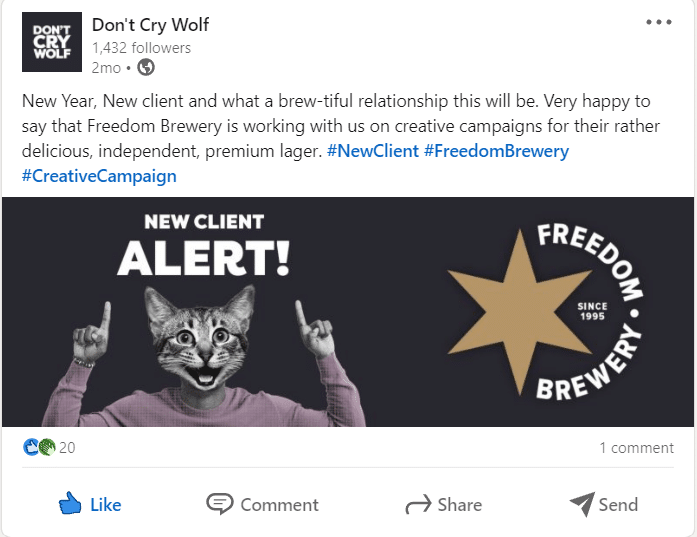Building a successful agency-client relationship is essential for marketing agencies. Happy clients are retained clients, which will save you time and ultimately budget on acquisition in the long term.
But do you just wing it and hope the relationship goes well and the client is happy?
Nope.
I’ve honed agency client relationship skills over the years at my marketing agency. Here’s my guide for establishing the perfect framework for an honest, friendly, and productive relationship.
What Is an Agency Client Relationship?
An agency client relationship is the agreement between a business or brand (the client) and a marketing company (the agency). Most agencies will have the client sign a contract that details the scope of their mutual agreement and the payment terms. The scope of this contract often will include services such as content marketing, social media management, advertising and PR. However, that’s just a small part of it.
The agency client relationship then becomes the dynamic between the two parties. It’s about how an agency and a client communicate, pull together, overcome challenges, and achieve results. Whether the agency and client are happy is also important.
The agency client relationship matters to both the agency and the client, and is the key to a successful business partnership.
Traits of a good agency client relationship
- Mutual respect
- Good collaboration
- Honesty and transparency
- Relatability
- Humor and connection
- Accountability
Here’s my guide to building a successful agency client relationship.
1. Agency Client Relationship Tip: Under Promise, Over Deliver
My first piece of advice goes right back to when you’re making the sale. You want to win the business and you’re a marketer, so you know how to promote your agency. But avoid making claims you can’t live up to.
If you’re a boutique agency, say so.
If you don’t handle paid ads, then be upfront about it. Clients want an honest relationship with their agency. They want to hire people who are great at what they do. Not a team that over exaggerates their capabilities and comes unstuck later.
How to under promise and over deliver
- Be clear about the services you can provide and back this up in writing.
- Don’t be afraid to turn away work that doesn’t fit your skills and team.
- Ask lots of questions before you accept the business. Even if clients are in a hurry, slow them down to be sure you fully understand what’s expected of you.
- Add extra treats for your client. That might be a complimentary post, free tickets to a show, or a PR mention in one of your articles. We all love to feel valued and special. Aim to share the love with your clients.
- Highlight when you go above and beyond for clients or achieve better than expected results. For example, you can do this by screenshotting outstanding results in your Agorapulse reporting and explaining what they mean. Who doesn’t love those green upwards arrows?!
2. Agency Client Relationship Tip: Set Clear Goals and Agree on KPIs
As an agency director, I rarely see clients come to me with tangible or measurable goals. Clients want you to make their marketing better, but they don’t necessarily know what that looks like.
That’s OK. Your agency clients are not marketers.
As marketers, we have the job to steer that conversation at the start. That might involve going through each social media channel to see what the client likes and doesn’t like. If they don’t like how few likes each Facebook post gets, then increased engagement could be a social media KPI for them.
If they don’t like that their content isn’t ranking on Google, then attaining Featured Snippets and page one rankings within six months could be a goal.
How to set goals and agree on KPIs
- Set clear goals for success at the start and have all the key stakeholders agree. Be sure to include timescales. None of you are ending up on the SERP (Search Engine Results Page) within a week!
- Push back on unrealistic goals or KPIs. There’s no point in agreeing them now and failing at them later.
- Be clear about how you plan to showcase ROI. For social media you can do this using Agorapulse’ reporting. You can also try out their new ROI feature!
- Agree on a realistic timeframe for reporting and stick to it. Clients love consistency in an agency’s invoicing and reporting. Read more reporting tips here.
3. Agency Client Relationship Tip: Onboard Them Properly
Onboarding a client involves signing contracts, agreements, and NDAs. It’s also about receiving brand guides, tone of voice documents, logos, banners, and content strategies. Onboarding a client involves setting the stage for the clear communication and seamless execution needed for a strong and long-lasting client relationship to form.
How to properly onboard agency clients
- Send your clients a welcome pack. Clients love to get agency merchandise! Send them some branded pens, hats, notepads, and cooler stuff. You’re a marketing agency. You know all about amazing merch.
- Be clear about how clients can contact you and when. If your hours are 8AM to 4PM, tell them. If they can contact another member of the team, make sure they have the details. Have one or two clear channels of communication with your clients, so you check them regularly. I use email and Skype, for example. You don’t want clients pinging you the same message on Instagram, TikTok, and WhatsApp at midnight!
- Define an “emergency,” so your clients understand where the line is drawn. A huge PR disaster is an emergency. Having an idea about a LinkedIn campaign is not.
- Decide whether you will join a client’s project management system. Some agencies choose to do this, and others don’t. Keep in mind that you may end up with clients on all different systems like Slack, Teams, Basecamp, and Trello. This might cause you organizational problems later.
- Get all the logins and passwords you need in one hit. Check that everyone can access the things they need.
- Host a kickoff meeting where your team can meet their team. This is not the same as a strategy meet, which will generally just have key stakeholders on it from each side.
- Announce it on social media (if the clients agree first) to show you’re excited to onboard them like Don’t Cry Wolf.
4. Agency Client Relationship Tip: Be a Great Communicator
One of the quickest ways to lose a client is to stop communicating with them. I know because new clients frequently tell us it’s why they left their last agency.
Keep your agency clients in the loop of what’s going on with their campaigns. And if things aren’t going according to plan or there’s a problem? Talk to them about that, too.
By actively involving the client, you’re less likely to lose them later.
How to be a great communicator in the agency client relationship
- Get notes in writing. If the client requests something different over the phone, then ask them to put it on an email. This is twofold. First, it stops you from forgetting during a busy day. Second, it means everyone is on the same page, and both parties are accountable.
- Aim to answer emails within a set time. (Usually, one business day is fine.)
- Schedule regular catchup meetings to go over reports, ideas, concerns, and planning. How regularly depends on the client and the scope of work. There’s no need to tie up your whole team (and theirs) if there is nothing to discuss. Plan your meeting agenda, so you cover everything in an organized way.
Let’s dig more into just how that communication needs to be honest …
5. Agency Client Relationship Tip: Welcome (and Provide) Honest Feedback
It’s great to tell clients that you welcome their feedback and questions, but do you mean it? If you don’t make time to listen to your clients, or worse still, you provide a hostile front when they do give feedback, then they simply won’t.
If your agency clients feel they are not being listened to, they might end the agreement and find a new agency.
How to provide honest feedback in an agency client relationship
- Don’t be defensive; listen well. The client’s feedback is going to make you better at what you do. It’s a learning lesson. Plus, even if the feedback is negative, it shows that they want to continue working together. Listening to feedback and providing positive solutions is what clients love about a professional agency.
- Be aware of your tone when a client provides feedback. Using phrases like “I see what you’re talking about,” “I hear you on that,” or “This is a valid concern” show that you are open and listening. You can also go one step further and say, “Let’s make a plan to review this and report back with some solutions.” Then diary it, and do it!
- Provide honest feedback in return. There may be things you want your client to stop doing (adding everyone to Google Drive sheets!) Don’t let the frustrations build up. Be honest and provide ways to improve the streamlining of your work.
- Don’t be afraid to disagree with agency clients. They are not paying you to be a yes (wo)man. They are paying you to be a marketing expert.
- Socializing where you can is important. That might look like a coffee if you’re passing their office, lunch at an expo you’re both attending, or even sharing a fun GIF or meme via email. Being sociable with clients builds rapport and helps smooth the working relationship.
Agency client relationships don’t last forever, but the breakup is usually not because they were unhappy. Perhaps the client hired inhouse, they changed strategy, or their budget dropped.
Whatever the reason, be sure to get their feedback when the agreement comes to an end. What did they love about you? What would they change? And do they have any other feedback?
If they loved you, then get a Google review from them to help you showcase your work to potential clients. You can also style them to share on social media as we did below.
In Conclusion About Agency Client Relationships
Strong agency client relationships make for greater success with projects, greater retention and a better brand reputation. Most importantly, they make work fun and keep the creativity flowing.
Get started on deepening the success of your social media agency! Schedule a free demo of Agorapulse to help you schedule, track, and measure all your social media efforts.









